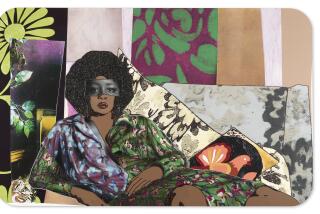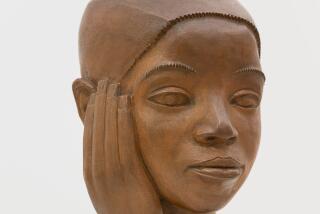The works get very personal for Lezley Saar
Lezley Saar is only slightly out of her element in “Inscribing Meaning: Writing and Graphic Systems in African Art” at UCLA’s Fowler Museum.
An artist who became known for transforming old books into assemblages, she is now making strange wall pieces that she likens to a new form of language. So, without much hesitation, she agrees to walk through the sprawling exhibition and talk about pieces that pique her interest. That means perusing more than 100 African works that explore relationships between art and written communication throughout history, so she gets right down to business.
“Artists are more interested in what they are thinking about now than what they did in the past,” she says, walking straight through a section on artists’ books and heading for “Samira’s Story,” a big, bold, contemporary wall piece by Fathi Hassan in a gallery devoted to word play. Working in black acrylic on unstretched canvas, the artist has filled all but the border of the fabric with loosely brushed black script that appears to be a form of Arabic. A few large characters stand out against a calligraphic background of smaller “writing,” which spills into the border on the bottom.
“This appeals to me on a visual level, an abstract level,” Saar says. “I have the sense that he is playing with the script, stretching and altering it to create some sort of language. My first impression -- I try to look before reading the labels -- is that this is a bird’s eye view of a landscape. There might be water, rivers going through here. It’s very beautiful.”
Beyond its palette, the painting bears little resemblance to Saar’s recent work. She shoots black-and-white photographs of landscapes and kitschy statuary -- whatever catches her eye -- cuts out circular sections of the prints and mounts them on white paper backgrounds. Then she encapsulates the circles in ink-drawn networks of roots, vines, drips, sprouts and foliage. Like mirrored bubbles or peep-holes, the little round pictures seem to exist in a fantasy world.
But there’s a back story.
A member of a prominent artistic family, Saar is often identified with her assemblagist mother, Betye, and sculptor sister, Alison. But Lezley’s new work reflects the complexities and frustrations of figuring out modes of communication used by her 16-year-old autistic daughter. Titles of works in her recent show at Walter Maciel Gallery -- such as “Well, consider this about villains of the month,” “No guests eating other guests” and “The pail stays in the freakin kitchen” -- are taken from repetitive statements made by her daughter.
“This makes me think of what I’m doing now,” Saar says of Hassan’s work. “Not using text so much, except for titles taken from bizarre things my daughter has said. But I feel that I am creating a language from five sources: botany, anatomy, tattoos, cartoons or caricatures and Japanese landscapes. Instead of drawing in one style, I use different styles or sources as parts of speech. An image from a tattoo magazine might be a noun; something Japanese might be an adjective; something botanical, a verb.
“I start without planning, more like the process of writing and seeing where it leads. I think about it as symbols and graphics and language, and then use photographs related to the idea of another world. There is reality in the photographs, but they are ensconced in the whole. It ends up being like a narrative or a landscape with lots of detail. You have to come up close to get the whole picture and experience.
“Not knowing Arabic,” she says, “I don’t know exactly what this artist is doing, but he is certainly using language to create a form. I’m sure there’s a lot more going on, though. He seems to be questioning the notion of written language and the importance of that.”
Art is always subject to interpretation, but Saar is on target, says Polly Nooter Roberts, an African art scholar who co-curated the exhibition with Christine Mullen Kreamer of the Smithsonian’s National Museum of African Art. “The artist is Nubian,” she says of Hassan, whose family relocated to Cairo in 1902, when their homeland was destroyed by the construction of the Aswan Dam. “He comes from the tradition of Meroitic script, which has not been fully deciphered.” Although Arabic speakers find recognizable words in some of his paintings, she says, “he is playing with issues of legibility and questioning to what degree legibility is the key to knowledge.”
Neatly turned out in jeans, knit top and leather jacket, Saar has a gentle manner and a broad comfort zone with all kinds of art. Her next stop is in a gallery that associates writing with power. “This is very strange,” she says, peering at a chimpanzee skull with wads of red and black cloth and braided hemp attached to it. Inscribed with Arabic script and a checkerboard-like pattern of talisman squares, it is thought to have been used in Islamic healing rituals in 19th century Liberia. In accordance with conservators’ instructions, the skull is displayed with the braid stretched out behind it.
“Talk about ‘Inscribing Meaning,’ ” Saar says. “A lot of the meaning can come from how a work is set up. This belt or braid was probably used to hold the skull, but the way it’s laid out, it looks like a tail. This skull of a chimpanzee has morphed into this phenomenal creature. And it has this fabric wrapped around it, which I’m sure has spiritual or religious significance, but to me it looks like a little dress.
“I think about this in group shows. Placing one piece next to another can change the connotation. Art is being continually created and added upon.
“Here, the object itself, a skull, is a very powerful thing, and the Arabic writing on it really makes it intriguing. You wonder how long ago people realized that thought and language emanated from the brain. It’s intriguing to me because of having a daughter who was diagnosed as autistic when she was 2. Language was a big thing with her.
“She had language, lost it at 18 months and gradually got it back at 7. Then, when she was in middle school, she decided to stop talking for a year and a half and expressed herself through signage. Now why would it be easier to sign? She could spell and read and get the words out.
“I find it fascinating, and I question the idea of neurological normalcy. I heard the mother of an autistic daughter saying that after a while other people think you are autistic too. To make your life work, you have to embrace your daughter’s world.”
That said, Saar is off to the Sacred Scripts gallery, where she points out another contemporary wall piece, “Qaf ‘Al Asmie Tales’ ” by Ali Omar Ermes. Working in acrylic and ink on paper, the artist has corralled much of the space with a sweeping reddish-brown gesture and filled in the rest with soft blotches of color and passages of spidery text, including lines of Arabic poetry.
In a catalog essay, Ermes says he “visualizes literature” in his calligraphic paintings. For Saar, the work inspires thoughts about the beauty of written language. “I love the tiny details and how it flows,” she says. “It seems so fluid, as if it’s unplanned. Parts of it are faded, but bright colors pop out. It has an ancient look, but it’s also contemporary.”
A tiny Egyptian statue of a female figure, circa 332-30 BC, is also irresistible. “It’s so delicate and beautiful. I just want to touch it,” she says of the black stone “cippis” -- defined in the wall label as “a stela or tablet inscribed with mystical images and spells that offer protection from illness, including those caused by wounds and poisonous bites.”
“The figure, Isis, is standing on crocodiles,” Saar says. “I guess the story is her son had a scorpion bite and she cured him. But the image of this woman standing on these crocodiles seems so peaceful. The juxtaposition of danger and being very calm -- it’s like standing on danger after curing something life threatening.
“Not to get personal again, but it relates to this idea of encompassing my daughter’s world and trying to understand it. For her to have a feeling of someone understanding her calms her down. Sometimes it feels like standing on crocodiles.”
--
‘Inscribing Meaning’
Where: Fowler Museum at UCLA
When: Noon to 5 p.m. Wednesdays through Sundays; noon to 8 p.m. Thursdays
Ends: Feb. 17
Price: Free
Contact: (310) 825-4361 or www.fowler.ucla.edu
Also
‘The Word in L.A.: Panel Discussion With Artists Robbie Conal, Alexandra Grant and Lezley Saar’
Where: Fowler Museum at UCLA
When: 2 to 4 p.m. Feb. 3
Price: Free
Contact: (310) 825-4361 or www.fowler.ucla.edu
More to Read
The biggest entertainment stories
Get our big stories about Hollywood, film, television, music, arts, culture and more right in your inbox as soon as they publish.
You may occasionally receive promotional content from the Los Angeles Times.










